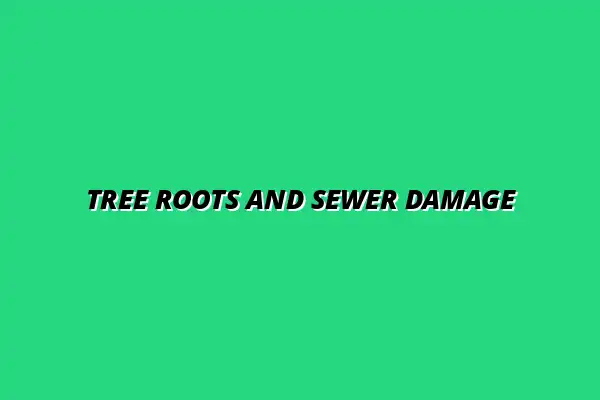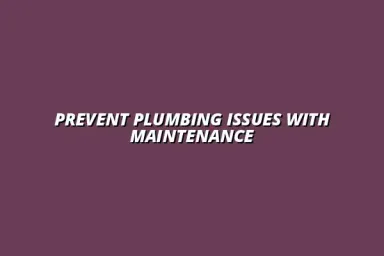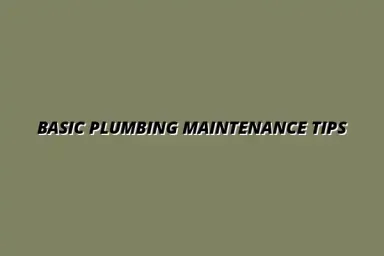Understanding the Relationship Between Tree Roots and Sewer Systems
Tree roots are not just essential for a tree's stability and nutrient intake; they can also pose serious risks to sewer systems. Understanding how tree roots interact with sewer pipes is crucial for homeowners and landscapers alike. This relationship can lead to costly repairs and significant damage if not managed properly.
Roots naturally grow in search of water and nutrients, often leading them toward sewer lines, which provide both. The challenge arises from the combination of root growth patterns and the vulnerabilities that exist within sewer systems. Today, we will explore the various factors that influence this relationship. For example, leaking pipes can significantly attract tree roots. Learning how to prevent water heater leaks is a crucial step in maintaining a healthy plumbing system and deterring root intrusion.
The Natural Growth Patterns of Tree Roots
Tree roots typically expand in a pattern dictated by the tree species and environmental factors. Most roots grow outward from the trunk, seeking moisture and nutrients in the soil. Understanding these natural patterns can help homeowners make informed decisions about landscaping and tree placement, especially within proximity to sewer systems.
Tree roots are always in search of water sources, which can lead them to penetrate sewer lines. When roots encounter a moisture-rich environment, they tend to grow larger and more aggressively. It's essential to recognize that roots can spread far beyond the tree's canopy, making their reach much broader than many might expect. This aggressive root growth can lead to sewer pipe backups and other serious plumbing problems.
How Tree Roots Seek Water Sources
Roots are incredibly adaptive and can sense moisture through various means. They often gravitate toward:
- Leaking sewer lines
- Moisture-retaining soils
- Surface water from rain or irrigation
As roots detect these moisture sources, they can infiltrate cracks in sewer pipes, seeking out the water they need. This behavior is a significant factor in root invasion within plumbing systems.
The Influence of Soil Conditions on Root Expansion
The condition of the soil plays a vital role in how roots grow and expand. Factors such as soil composition, drainage, and compaction can influence root behavior. For example, loose, well-drained soil encourages roots to spread more extensively, while compacted soil may restrict their growth.
Soil moisture levels also impact how aggressively roots will grow. In dry conditions, roots might search further for water, increasing the chance of encountering sewer lines. Homeowners should be aware of these soil conditions when planting trees to minimize the risk of root invasion. Understanding the causes of bursting water pipes can also help prevent issues stemming from root intrusion.
Common Types of Trees Known for Root Problems
Not all trees pose the same level of risk to sewer systems. Some species are notorious for their aggressive root growth, which can lead to significant plumbing issues. Identifying these trees can help homeowners avoid potential headaches in the future.
Some common trees known for problematic roots include:
- Willows
- Maples
- Oaks
- Pines
These trees tend to have extensive root systems that can penetrate sewer lines, resulting in clogs and damage. By being mindful of these species, homeowners can make better landscaping choices to protect their sewer systems. To learn more about preventing tree roots from damaging pipes, visit this helpful resource: Prevent Tree Roots from Damaging Pipes.
Identifying Invasive Tree Species
Invasive tree species can exacerbate root issues due to their rapid growth and adaptability. Some invasive trees can spread quickly and develop extensive root systems that seek out water sources effectively. Homeowners should watch out for:
- Tree of Heaven
- Black Locust
- Norway Maple
If you suspect that your yard contains any invasive species, consider consulting with a local arborist to assess the risks and determine the best course of action.
How Tree Size and Age Impact Root Growth
As a tree grows older and larger, its root system also expands. Mature trees have far-reaching roots that can increase the chances of invading sewer lines. Additionally, younger trees might not pose immediate threats, but as they grow, their root systems can become more problematic. Regular maintenance of your kitchen plumbing can help prevent issues that may attract tree roots. Check out tips on preventing grease buildup in pipes.
It's essential to monitor trees as they age and assess their proximity to sewer pipes regularly. Homeowners should keep an eye on both the size of the tree and the condition of nearby plumbing to prevent future issues.
Preventive Measures Against Tree Root Invasion
Preventing tree root invasion in sewer lines is essential for maintaining the health of your plumbing system. Homeowners can take a few proactive steps to minimize the risk of roots damaging their sewer pipes. By understanding the relationship between trees and plumbing, we can create a safer and more manageable landscape around our homes!
One effective way to protect your sewer lines is to choose the right trees for your landscape. It’s important to select species known for having less aggressive root systems. Additionally, implementing structural measures like root barriers can also be a significant step in keeping roots at bay!
Strategies for Homeowners to Protect Their Sewer Lines
Understanding how to create a healthy balance between landscaping and plumbing can save homeowners a lot of time and money. By selecting the right tree species and implementing protective measures, you can greatly reduce the chances of root invasion. Here are some effective strategies:
- Plant trees that are known to have shallow or non-invasive roots, such as dogwoods or flowering cherries.
- Establish a minimum distance between trees and sewer lines, ideally at least 10 feet.
- Consider using native plants that are well adapted to your local soil and moisture conditions.
Another way to protect your sewer lines is to install root barriers. These barriers can be physical or chemical, creating a strong line of defense against invasive roots. Proper placement and installation of barriers can significantly reduce root encroachment into your plumbing system. For help with plumbing issues in Birmingham, consider contacting a local professional like PlumbProCare.
Choosing the Right Trees for Your Landscape
When selecting trees for your yard, it’s wise to consider their potential impact on your sewer system. Trees with aggressive, deep root systems are more likely to cause damage. By choosing trees with less invasive root structures, you can mitigate potential issues right from the beginning!
- **Maple**: While beautiful, their roots are known to spread widely.
- **Willow**: These thrive near water and can invade sewer lines easily.
- **Birch**: They have shallow roots that are generally safer for plumbing.
Additionally, consult local landscaping professionals or extensions to learn about tree species that are suitable for your area. This knowledge can help ensure a healthy, vibrant landscape without compromising your sewer health. Maintaining a healthy bathroom can also contribute to a healthy sewer system. Read more about healthy bathroom sewer line tips.
Implementing Root Barriers
Root barriers are physical installations that can help redirect roots away from sewer lines. These barriers can be made from various materials, such as plastic or metal, and should be buried deep enough to intercept growing roots. Installing root barriers could be one of the most effective steps you can take to protect your sewer system!
Placement is key when it comes to root barriers. Ideally, they should be installed in a straight line between trees and sewer lines. This helps create a strong defense against the roots trying to invade your plumbing.
- **Install barriers at least 2 feet deep** to effectively block roots.
- **Ensure barriers are wide enough** to cover the entire area where roots might grow.
- **Regularly check barriers** for any signs of wear or damage.
By staying proactive and implementing these strategies, homeowners can significantly reduce the risk of tree roots causing havoc with their sewer lines.
Regular Maintenance Practices
Regular maintenance is vital for preventing tree root problems in sewer systems. Incorporating routine inspections and timely interventions can save you significant costs down the line! It’s important to stay vigilant and maintain your landscape while keeping an eye on your plumbing health.
Developing a maintenance schedule is essential. This can include regular visual checks of trees and sewer lines, as well as professional inspections. It’s easier to fix a problem early rather than dealing with major repairs later!
How Routine Inspections Can Save You Money
Completing regular inspections of your sewer system can help identify potential issues before they escalate. By looking for signs of root intrusion, you can address problems promptly. Staying proactive can ultimately save you on costly repairs and keep your family safe!
- **Inspect trees for overgrowth** and assess their root patterns.
- **Check for slow drainage** in your plumbing as a potential warning sign.
- **Hire professionals** to conduct deeper inspections using cameras or specialized equipment.
This proactive approach will give you peace of mind. And it ensures the integrity of your sewer system, allowing you to focus on enjoying your home and garden.
Best Practices for Trimming Trees and Monitoring Growth
Regularly trimming trees can help manage their growth and prevent roots from becoming a problem. By keeping trees well-maintained, you can significantly reduce the risk of root invasion. It's a simple yet effective way to stay in control!
When trimming, it's important to follow best practices to maintain healthy trees while minimizing risk to your sewer lines. This includes cutting back branches that could potentially lean toward your plumbing system.
- **Trim trees at least once a year** to keep them in check.
- **Monitor any changes in growth** patterns that could indicate root issues.
- **Consider professional tree services** if you're unsure of how to properly maintain your trees.
By maintaining a routine of inspection and trimming, you can help protect your home from the troublesome effects of invasive tree roots!
FAQs About Tree Roots and Sewer Pipe Damage
When it comes to tree roots and sewer systems, many homeowners have questions. By addressing common concerns, we can equip ourselves with the knowledge necessary to manage potential issues effectively. Let’s dive into some frequently asked questions!
Knowing what to do when you suspect tree roots in your pipes is crucial. Taking the right steps early on can help prevent significant damage and costly repairs. Here are some essential actions to consider!
What to Do if You Suspect Tree Roots in Your Pipes
If you suspect roots are causing problems in your plumbing system, the first step is to remain calm and assess the situation. Early detection can be your best friend in avoiding expensive repairs! Here’s what you can do:
- **Listen for strange noises** in your plumbing, such as gurgling sounds.
- **Check for slow draining** and backflow in sinks and toilets.
- **Inspect your yard for signs** of lush growth around sewer lines.
These signs can help you identify potential root problems before they become severe. If you notice any of these issues, it's best to consult a professional soon!
Steps to Take Before Calling a Professional
Before reaching out to a plumber, there are a few steps you can take. Gathering information can provide valuable insights when discussing the issue with a professional. Here’s a simple checklist:
- **Document any unusual plumbing behaviors** or signs of sewage backups.
- **Take note of tree locations** and their proximity to sewer lines.
- **Look for visible signs of root intrusion** around trees and pipes.
Once you have this information, you'll be better prepared for the conversation with your plumbing expert.
Common Professional Solutions for Root Removal
When it comes to dealing with tree roots in sewer pipes, professionals have various solutions. Understanding these options can help you make informed decisions about your plumbing system! Here are some common methods:
- **Mechanical Root Removal**: This involves cutting roots using specialized equipment.
- **Hydro Jetting**: High-pressure water jets are used to clear obstructions.
- **Chemical Treatments**: Special chemicals can be applied to inhibit root growth.
Each solution has its pros and cons, so it's essential to discuss these options with your plumber to determine the best approach for your situation.
How to Identify the Right Professionals for Sewer Issues
Finding a qualified professional to address sewer problems is crucial. The right expert can make all the difference when it comes to resolving issues effectively. Here are some tips to help you identify the best plumbing services!
Always look for a plumbing service that is licensed and insured. This helps ensure that you’re working with a trustworthy professional, which is a key factor in maintaining your home. Additionally, experience in dealing with tree root issues is a huge plus!
Key Qualifications to Look for in Plumbing Services
When searching for a plumbing expert, you should consider a few essential qualifications. Having the right credentials can give you confidence in their ability to handle your sewer issues effectively! Here are some qualifications to look for:
- **Licensing and Insurance**: Verify that they are fully licensed and insured.
- **Experience with Root Issues**: Ask how long they’ve been working with tree root problems.
- **Customer Reviews and References**: Check online reviews and seek recommendations from friends.
These factors will help you find a reliable professional who can address your plumbing needs effectively!
Understanding the Costs Involved in Hiring Experts
Hiring professionals for sewer issues can come at a cost. It's beneficial to have a clear understanding of what to expect regarding expenses. Here are common factors that can influence costs:
- **Type of Service Needed**: Different solutions come with varying price tags.
- **Urgency of Service**: Emergency services often cost more than regular appointments.
- **Extent of Damage**: More severe root invasions may require extensive repairs.
By being informed about these factors, you can budget accordingly and make a more informed decision about hiring professionals.
Final Thoughts on Managing Tree Roots and Sewer Health
Managing tree roots and ensuring the health of your sewer system is a balancing act. By making thoughtful landscaping choices, we can keep our homes safe from potential plumbing issues. Awareness of the relationship between trees and sewer lines is essential for every homeowner!
It’s about creating a sustainable landscape plan that considers the long-term effects on both the environment and your plumbing system. Taking preventive actions today can lead to a healthier home tomorrow!
Balancing Landscaping Choices with Sewer System Integrity
Finding a balance between landscaping and sewer system integrity is key to preventing root-related issues. We can create beautiful outdoor spaces while safeguarding our plumbing. This requires thoughtful planning and regular maintenance!
As we design our landscapes, it’s wise to consider the potential impact of our tree choices on plumbing health. With careful thought and planning, we can create gardens that enhance our properties without risking damage to our sewer systems!
Creating a Sustainable Landscape Plan
Crafting a sustainable landscape plan involves selecting appropriate trees, maintaining them, and monitoring growth regularly. It’s about making choices that benefit both nature and our homes! Here are some tips for a successful plan:
- **Choose native plants** that thrive in your area.
- **Incorporate a variety of plants** to create a diverse ecosystem.
- **Plan for regular maintenance** to keep everything in check.
By implementing these strategies, you can enjoy a beautiful landscape while ensuring the long-term health of your sewer system!
Importance of Community Awareness and Education
Educating ourselves and our communities about the relationship between tree roots and sewer systems is vital. The more we know, the better we can manage our landscaping and plumbing effectively. Community workshops and resources can foster this awareness!
Encouraging discussions within your neighborhood about best practices for landscaping can lead to a collective effort in maintaining plumbing health. Together, we can create more informed communities that prioritize both beautiful landscapes and functional sewer systems!

 Kiran Almasi
Kiran Almasi

